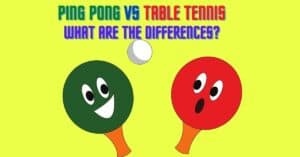The idea of table tennis terminologies is important for beginners or recreational players to approach the game confidently. This article covers easy definitions of 35 common terms used in table tennis (also known as ping pong) to depict an overview of the sport.
35 Table Tennis Terms from a Beginner’s Point of View
Backhand: Backhand shots are taken on the non-dominant side of your body with your dominant hand coming into action with the back side of the palm facing toward the direction of the shot.
Backspin: Backspin is the backward rotation of the ball. Backspinning means brushing under the ball with the racket. This technique is frequently used in service and for defensive shots like chops and pushes.
Blade: This inner part of a racket is made with wooden or composite materials consisting of wood and carbon.
Block: A defensive shot, close to the table, is taken just after the ball bounce with minimal movement of the racket.
Chop: Chop is a defensive return, taken away from the table by backspinning the incoming ball.
Chop Block: Chop block is a high-risk shot taken close to the table with short-arm action that often brings desired results. This is a short stroke with the help of backspin and sidespin by using the opponent’s speed and spin.
Deuce: ‘Deuce’ occurs when a set is tied at 10-10. In this situation, a lead of 2 points is necessary to win the game/ set.
Doubles: In doubles, two teams participate in a match pairing 2 players each.
Drive: It is a basic table tennis shot, taken close to the table by the forward and slightly upward movement of the racket arm pointed toward the direction where the ball is going to travel.
Drop Shot: A drop shot is imparted by dropping the ball very close to the net on the opponent’s side. This is a clever shot when the opponent is away from the table.
Flick/ Flip: It is an offensive shot to tackle a short ball by topspinning the ball over the table using wrist action.
Forehand: Forehand strokes are taken on the dominant side of your body with the palm facing toward the direction of the shot.
Inverted (Pips-in) Rubber: It is the common type of rubber where the pimples are facing inwards and the outer playing surface is smooth.
ITTF: International Table Tennis Federation (ITTF), the governing body of table tennis
Let: Let is a frequently used term in table tennis to interrupt the play. The most common occurrence is the let serve when the ball touches the net but otherwise is correct.
Lob: It is a defensive shot taken away from the table by placing a high ball against an attacking shot.
Loop: ‘Loop’ is the most used shot in modern table tennis. It is a powerful heavy topspin drive that involves the flexible wrist for brushing the ball with an upward and forward movement.
Match: A table tennis match consists of 3, 5, or 7 sets or games.
Multi-ball: It is an effective training practice by continuously feeding balls for the development of skills.
Penhold: This terminology in table tennis refers to the holding technique, mainly used by Asian players. In this form of grip, the index finger and thumb are curled around the edge of the paddle to form a ‘C’ shape and the other three fingers act the supporting role on the other side of the rubber. It looks like you are holding a pen.
Pips-out: A special type of rubber in which pimples are facing outward.
Point: Point is the elementary term used in the scoring system.
Push: Push is a soft defensive backspin shot, usually used for returning short backspin balls.
Rally: A rally is an exchange of shots between two players. A rally starts with a serve and results in a point.
Rubber: Rubbers, the outer part of a racket, are pasted on a blade to form a racket. A rubber consists of a topsheet and a sponge. Rubbers are of two types, pips-in or inverted (pimples facing inward) and pips-out (pimples facing outward).
Serve: A rally starts with a serve. The first bounce of service must be on your side and the second bounce on your opponent’s side by crossing over the net.
Set: This terminology indicates scoring in a table tennis match. A set consists of 11 points if not tied at 10-10.
Shakehand: It is the most common grip to hold a racket that looks like you are shaking your hand.
Sidespin: Sidespin is the sideways (right or left) angular rotation of the ball.
Singles: In this format, two players contest against each other in a table tennis match.
Smash: Smash is a powerful offensive shot to force your opponent to go to the backfoot. Smash is imparted by hitting a high ball with a flat contact. The object is to generate maximum speed, not spin.
Spin: Spin is the angular rotation of a ball. There are three types of spin, topspin, backspin, and sidespin.
Stance: “Stance” is the readiness before returning a service by placing feet and transferring body weight.
Time-out: This rule allows each player or team to opt for a one-minute break during the entire period of a match.
Topspin: Topspin is the forward rotation of the ball that can be created by brushing on the top of the ball with the racket. This technique helps to build consistency in the game. It is the most effective way for returning a backspin ball.
Download Table Tennis Terminologies PDF



